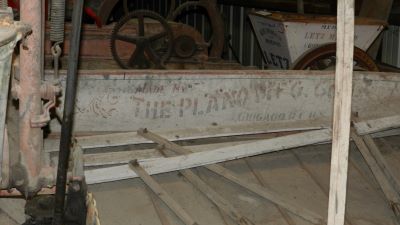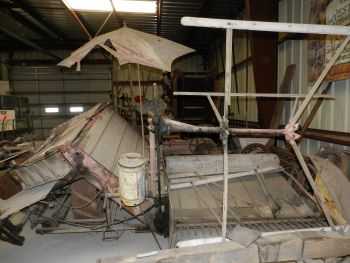Grain Binder
Cutting Grain
The Museum has an example of a Plano Manufacturing Company binder on display. It embodies the features of the old McCormick reaper. It is pulled by horses (or a tractor) from one side so as not to trample down standing grain. Power comes from a large bull wheel, and there is a platform, cutter bar (sickle), and reel on the other side. But the manual tasks of raking grain stalks from the platform and binding them into bundles has been eliminated.


The cut grain falls onto the platform, which now has a moving belt (platform canvas) made heavy canvas with hardwood slats riveted to it. The platform moves the grain across the platform where it is sandwiched between two elevator canvases and raised up to the bundle tying machinery. The grain stems slide down a sloping plate to be stopped by a metal finger. Two other reciprocating metal fingers are packing the stems, and at the front end of the binder, a short rotating canvas belt aligns the bottoms of the stems more or less evenly (The Plano binder had a rotating belt, other binders used a toothed oscillating plate that accomplished the same thing). The pressure of the accumulating stems pushing on the restraining finger eventually trips it back slightly. This releases the semicircular needle carrying twine to swing up and over the stems to the knotter. By a complex process, the knotter ties the twine round the center of the stems, cuts the twine and retracts, the restraining finger swings out of the way and two arms swing around to eject the freshy tied bundle. The bundle falls into a carrier made of metal rods attached to a rod at the front. The carrier is held up by the operator pressing on a foot pedal below his seat. After four or five bundles have accumulated, releasing the foot pressure lowers the carrier to the ground and allows the grain bundles to slide off. Dumping the bundles is done so each pile is in a straight line to make it easier for shocking and loading the shocks. The operator rides on a seat behind the binder at the right side of the platform. Besides guiding the horses and dumping the bundles, he has two levers that changed the height of the reel and how close the reel is to the platform. A third lever moved the entire bundle-tying apparatus forward and back to tie the twine approximately in the middle of the bundle depending on the length of the grain. Another sliding lever adjusts the packer horizontally in and out as this was changed. The twine used was usually a cheap 1/8th inch commercial sisal twine produced by twisting the fibers together. At the front of the binder is a round metal container that holds two 6 inch high by 7 inch wide cylindrical balls of twine one above the other. The end of the twine in the center of the top ball is fed to the needle and knotter. The outside twine end is tied to the center end of the lower ball with a small tight knot (to continue to feed twine to the knotter) when the first ball was used up (the reason for feeding from the center of the ball is that the twine is twisted more as it is pulled out and does not unravel).
SOURCES:
https://kendallkin.org/county-history/town-histories/plano/harvester-story- 1908.html Published in the Kendall County News, June 17, 1908
Derry, Vernon. Plano, Birthplace of the Harvester. 1954. Printed for the 100th Anniversary of Plano, IL. 1854 – 1954.
Brumfield, Kirby. “This Was Wheat Farming” Superior Publishing Company, Seattle, Washington. 1968. p.53
John Deere Company. The Operation, Care, and Repair of Farm Machinery, 19th edition.
By Don McCollor. October 2022
Photos by Linda Westrom

